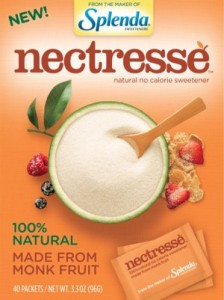All About Nectresse
 With obesity and diabetes on the rise, it’s no wonder that there are more companies jumping on the “no calorie all-natural sweetener” bandwagon.
With obesity and diabetes on the rise, it’s no wonder that there are more companies jumping on the “no calorie all-natural sweetener” bandwagon.
There are sugar-free options for just about everything these days; sugar-free cream for your coffee, sugar-free jelly for your toast, sugar-free cookies and even sugar-free salad dressings. But are these sweeteners really sugar free? Do they come calorie free? And just as important: Are they actually all-natural? Turns out – you should be careful about which sweetener you choose.
As someone who tries to eat as close to nature as possible, I find it very important to know what you are consuming. Reading every nutrition label and the ingredients might seem a little bit obsessed, but I believe it’s better to be obsessed about what you consume than to blindly eat whatever is out there. Plus, once you find a brand that meets your nutritional needs, you won’t have to do it again. You can just get in, grab it and go!
Artificial sweeteners currently approved by the FDA are (and in my opinion, the ones to avoid):
- Saccharin – SugarTwin or Sweet’N Low – 200-700 times sweeter than sugar – Oldest known artificial sweetener and absolutely wrapped with controversy regarding it being a carcinogen. My advice is to stay away.
- Aspartame – Equal or NutraSweet – 200 times sweeter than sugar – Approved in 1981
- Sucralose – Splenda – 600 times sweeter than sugar – Approved in 1999
- Neotame – Manufactured by NutraSweet – 7,000 – 13,000 times sweeter than sugar – Approved in 2002
- Acesulfame Potassium – ACK, Sweet One, and Sunett – Approved in 2002
Consuming too much fake sugar can cause gas, bloating and diarrhea. It can also trick your brain into thinking you’re eating real sugar – triggering binge-like tendencies with a lot of people. Let’s not mention the studies linked to cancer – it has been such a controversial subject for so long and will always be. So far, Stevia have been the best option (in my opinion) as far as what’s on the market today – I believe it is as close to being all-natural as you can get. But buyer beware: Companies have and will jump through verbiage loopholes to fool you for your trust in their brand!
Enter the newest sweetener to the market: Nectresse, manufactured by the same company who makes Splenda. I wanted to know everything I could about it – and what follows is my overall conclusion.
Nectresse Dissected:
McNeil Nutritionals, LLC., the manufacturer of Splenda brand, claims that Nectresse is an All-Natural, No Calorie Sweetener. However, once looked into further, I found myself (not so?) quite surprised.
The Nectresse website claims that it is made up of 100% natural ingredients and that it is primarily made from a very naturally sweet fruit called monk fruit, found on the steep forested mountains of New Zealand. But in my humble opinion, I don’t agree with the websites “all-natural” claims. Sure, they were able to jump through the loopholes to call it all-natural, but let’s take a deeper look into the 4 ingredients that make up Necresse:
- Erythritol: A sugar alcohol (sucrose) that is usually derived from corn in the US (because of how cheap it is) – which is mostly genetically modified. At the industrial level, it is produced from glucose by fermentation with a yeast, Moniliella pollinis. The upside is that it does not affect blood sugar, does not cause tooth decay, and is partially absorbed by the body (the remaining is excreted in urine and feces).
- Sugar: Can be from a number of sources, but more commonly from sugar beets from the US – also mostly genetically modified at an industrial level.
- Monk Fruit Extract: The good stuff!
- Molasses: A by-product of the beating of sugar cane, grapes or sugar beets into sugar. Sugar beets are very cheap and is genetically modified (GMO) – no good.
* Health Note: A company called BioVittoria located in New Zealand, claims to be working on a powder extract, as apposed to that of Stevia which is extracted from the plant. They say that turning a fruit in to a powder is more natural.
Nectresse contains 1 – 2 grams of carbohydrate per serving and it meets the FDA’s criteria for a Low Calorie Food.
One(1) packet, or 2.4 grams, is the serving size and has less than 1 gram of sugar, 2 grams of carbohydrates and 2 grams of erythritol. No calories, sodium, fat or protein per serving. Here are some helpful serving tips if you happen to want to try it out for yourself:
- 1/4 tsp. of Nectresse is equivalent to the sweetness of 1 tsp. of sugar
- 1 packet of Nectresse is equivalent to the sweetness of 2 tsp. of sugar
In a meal plan for those with diabetes, up to two(2) packets, or one(1) packet of Nectresse is considered a “free food.”
A free food is any food or beverage that has less than 20 calories and less than 5 grams of carbohydrates per serving, according to The Academy of Nutrition and Dietetics and the American diabetes Association.
So, all in all, would I recommend this?
It’s not something that I’ll particularly keep stocked in my kitchen – however, I would choose Nectresse over Splenda or any other artificial sweetener, white sugar, or anything else most commonly found in cafe’s and restaurants. I’d still stick with Stevia extract most of the time.
Now that you have my opinion and some facts – if this sounds like a product you’d like to try out for yourself, you can get a free sample at http://secure.nectresse.com/free-sample
If you order it, or have already tried it, let me know what you think! 🙂
